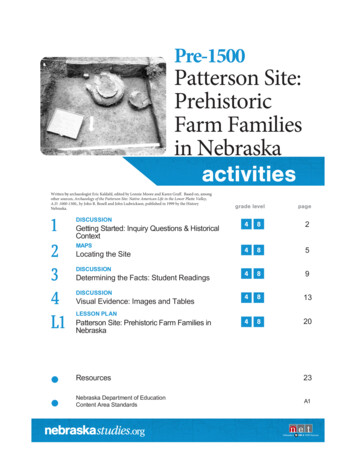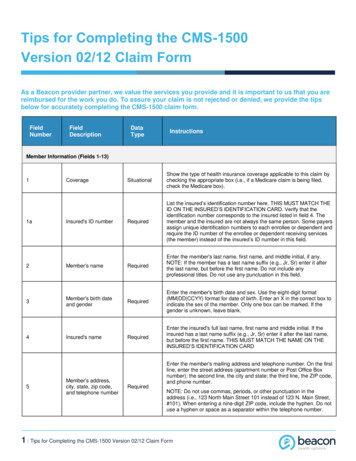
Transcription
Pre-1500Patterson Site:PrehistoricFarm Familiesin NebraskaactivitiesWritten by archaeologist Eric Kaldahl, edited by Lonnie Moore and Karen Graff. Based on, amongother sources, Archaeology of the Patterson Site: Native American Life in the Lower Platte Valley,A.D. 1000-1300,, by John R. Bozell and John Ludwickson, published in 1999 by the HistoryNebraska.1234L1 DISCUSSIONGetting Started: Inquiry Questions & HistoricalContextMAPSLocating the SiteDISCUSSIONDetermining the Facts: Student ReadingsDISCUSSIONVisual Evidence: Images and TablesLESSON PLANPatterson Site: Prehistoric Farm Families inNebraskagrade levelpage48248548948134820Resources23Nebraska Department of EducationContent Area StandardsA1
Pre-1500 Patterson Site: Prehistoric Farm Families in Nebraska1Getting Started: Inquiry Questions& Historical ContextActivity Grade Level48activityDiscussionHave students read the Patterson Site section on the SitesReveal Changing Ways page on the Nebraska Studies eal-changingways/Then, have students examine and discuss thesupplementary readings found on the following pages.Social Studies Standards: SS 4.3.1; SS 4.3.2; SS 4.3.3; SS 4.3.4; SS 4.3.5; SS 4.4.1; SS 4.4.2; SS .4.4.4 SS 8.3.2; SS8.3.3; SS 8.4.1; SS 8.4.2; SS 8.4.4; SS 8.4.52
Pre-1500 Patterson Site: Prehistoric Farm Families in Nebraska1Getting Started: Inquiry Questions& Historical ContextActivity Grade Level48Prehistoric Farm Families in Nebraska (A.D. 1000-1400)If we could look backwardsinto Nebraska's distant past,we would see rolling hills ofgrass, stream and riverbottoms filled with trees, andoverlooking it all, familieswho made their living inancient Nebraska. Between1000 and 600 years ago,many Native Americanscalled eastern Nebraska theirhome.These people usedeverything the land had tooffer. They cut wood from theforested hills to build.They used mud to seal their homes tight against winter winds and summer storms. They madecutting tools from stone, and cooking pots from clay. They farmed the land, harvested plants, andhunted animals for food and for clothes. Archaeologists call the culture of these farm families theCentral Plains tradition. These people left behind hundreds of ruins and artifacts that are thematerial fragments of their lives. They had no written language.Archaeologists study and preservethe past. They excavate the ruins ofancient homes. The Patterson sitewas one archaeological site that wasdestroyed little by little over the years:people needed to build new homes,and a highway needed to beimproved. Before the bulldozersturned the earth, archaeologists,school children, and volunteersexcavated at the Patterson site.This lesson will let you step into theshoes of a Patterson Sitearchaeologist. You will learn aboutthe lives of Central Plains traditionpeople who once lived there, and youwill learn about an ancient way of lifein Nebraska that lasted for 400 years.Unless otherwise noted, images throughout this lessonare Courtesy of the History Nebraska. The objectsphotographed for this lesson are from the collections ofthe History Nebraska.3
Pre-1500 Patterson Site: Prehistoric Farm Families in Nebraska1Getting Started: Inquiry Questions& Historical ContextActivity Grade Level48The photograph above shows the location of the Patterson site. When families of ancientfarmers lived here one thousand years ago, there were no grocery stores, no departmentstores, no hardware stores, no toy stores, no roads, no plumbing, no cars, no horses, no cattle,and no hogs. They had to make their own homes, get their own food, make their own clothes,and their own toys.QuestionsIf your family and your best friend’s family lived here 1,000 years ago, how wouldyou make a home for yourself? What would you use to build with? What do you thinkyou would eat? What could you make your clothes from? What kinds of games could youplay?4
Pre-1500 Patterson Site: Prehistoric Farm Families in Nebraska2Activity Grade LevelLocating the Site48activityMapsHave students read the Patterson Site section on the SitesReveal Changing Ways page on the Nebraska Studies eal-changingways/Then, have students examine the maps of the PattersonSite found on the following pages, and answer the questions.Social Studies Standards: SS 4.3.1; SS 4.3.2; SS 4.3.3; SS 4.3.4; SS 4.3.5; SS 4.4.1; SS 4.4.2; SS .4.4.4 SS 8.3.2; SS8.3.3; SS 8.4.1; SS 8.4.2; SS 8.4.4; SS 8.4.55
Pre-1500 Patterson Site: Prehistoric Farm Families in Nebraska2Locating the SiteActivity Grade Level48Map 1a: Patterson Site Location(The Patterson Site is marked with a red triangle labeled 25SY31)Map 1b: Central Plains Tradition Sites in Nebraska around A.D. 1000Questions for Maps 1a and 1b1. Locate the Patterson Site on Maps 1a and 1b. How would you describe its location?2. How many Central Plains tradition sites have been found in Nebraska that date to A.D. 1000?If you find it hard to count all the dots, estimate them. Is the number of sites greater than 20(sites 20)? Greater than 50 (sites 50)? Greater than 100 (sites 100)? Less than 1,000(sites 1,000)?3. Where in Nebraska did Central Plains tradition people live?6
Pre-1500 Patterson Site: Prehistoric Farm Families in Nebraska2Locating the SiteActivity Grade Level48Map 2: The Patterson Site NeighborhoodQuestions for Map 21. Look at the map legend. What kind of land is described in the key? Have you seen rollinghills or a river valley? What do these areas look like?2. What river is close to the site?3. What kinds of plants and animals do you find near the river and in the hills?4. What would be good about living there if you wanted to garden, hunt, fish, and gather wildplants?5. Using the map scale, how far from the Patterson site are other sites of the Central Plainstradition? Estimate how long it would take you to walk from the Patterson site to these othersites. [Hint: People can usually walk 2-3 miles in 1 hour.] They had no horses, no cars, andno bicycles, so they went everywhere by walking.7
Pre-1500 Patterson Site: Prehistoric Farm Families in Nebraska2Activity Grade LevelLocating the Site48Map 3: The Patterson SiteAfter archaeologists had studied the Patterson site, they found four house ruins buried under theground. House 2 has not been excavated, but Houses 1, 3, and 4 were excavated. In front ofHouse 2 was an area of trash. Archaeologists call an area of trash a “midden.” On top of theruin of House 4, they discovered that trash from later centuries had been tossed on top of theruin. Archaeologists also discovered that not all of the house ruins and trash were created at thesame time.Table of Dates CE CE CETime Period1050-11001100-12501250-1280 CE1280-1320 Unknown Time PeriodThe House Ruin or Trash Area People built and lived in House 4 No one lived at the site as far as we know People built and lived in House 3, and tossedtheir trash into Midden 1 and Midden 2 People built and lived in House 1 People built and lived in House 2Questions for Map 31. How many houses were found at the Patterson site?2. Using the scale on the map, how far apart were the houses at the Patterson site?3. Using subtraction, how long a period of time passed from when people lived in House 4 towhen people lived in House 3?4. Why do you think people moved away from the site and then came back?8
Pre-1500 Patterson Site: Prehistoric Farm Families in Nebraska3Determining the FactsActivity Grade Level48activityDiscussionHave students read the Patterson Site section on the SitesReveal Changing Ways page on the Nebraska Studies eal-changingways/Then, have students read the supplementary materials onthe following pages, and answer the questions.Social Studies Standards: SS 4.3.1; SS 4.3.2; SS 4.3.3; SS 4.3.4; SS 4.3.5; SS 4.4.1; SS 4.4.2; SS .4.4.4 SS 8.3.2; SS8.3.3; SS 8.4.1; SS 8.4.2; SS 8.4.4; SS 8.4.59
Pre-1500 Patterson Site: Prehistoric Farm Families in Nebraska3Determining the FactsActivity Grade Level48Student Reading #1: Central Plains Tradition Life (CE 1000-1400)Can you imagine a time before roads, grocery stores, cars, horses, doctors’ offices, and schools?Can you imagine a time before clothing stores, hardware stores, indoor plumbing, electricity,towns, and cities? Can you imagine a time before television, radio, cell phones, video games, andtoy stores? Can you imagine a time when eastern and central Nebraska did not have large farmfields? Can you imagine a time when our state was all rolling grassland, prairies, marshes,wooded streams, and forested river valleys?The time you imagined existed for thousands and thousands of years. The people who lived herein that time were Native Americans. Over those many thousands of years, Native American men,women, and children lived in many different cultures. We will talk about one of those cultures.Archaeologists call that culture the Central Plains tradition.The families of the Central Plains tradition were Native American people. They lived in Nebraskafrom CE 1000-1400. That means they lived here from 600 to 1,000 years ago. They werefarmers. The people of this culture lived in many parts of Nebraska. The largest numbers of themlived in central and eastern Nebraska.Much of what we know about Central Plains tradition people has been learned througharchaeology. Archaeology is the study of people and their cultures. Archaeologists study ancientcultures by examining the objects of past people. Artifacts are one kind of object. Artifacts arethings that people made in the past, like a basket or a bowl or deer hide shirt. Ecofacts areanother kind of object. Ecofacts are natural objects that past people used, like apples or walnutsor firewood.Central Plains tradition people left many artifacts and ecofacts behind. They built houses thatwere dug into the ground. We call these pithouses. Before building their homes, they dug a pitknee-deep to waist-deep into the ground. Each pithouse had one big room that was square inshape. A long ramp would connect the pithouse with the outside surface.After digging the pit for their house, they had to build the walls and the roof. Central Plainstradition people chopped down cottonwood, oak, and elm trees for building. They had no metaltools, so they chopped down trees with a kind of stone ax. Archaeologists call these axes celts.They would cut the tree trunks and branches down to the right size. Inside the pit of the pithouse,the home builders dug circular pits into the house floor. These little pits were just big enough tohold the posts for the roof supports and the walls.On top of the wall and roof posts were placed timbers for the roof. Thinner branches and stickswere attached to the wall posts and roof timbers. The whole structure was covered over withdaub. Daub is a sticky mixture of mud. The daub covering the house kept the rain and wind out.In the center of the home was a fireplace, called the hearth. A hole was probably left in the roof tolet the smoke from the fireplace out. Along the walls people placed their beds, probably onbenches made from wood. Storage pits were dig two to four feet deep below the floor. These pitswere used to store tools and to store food over the long winter.10
Pre-1500 Patterson Site: Prehistoric Farm Families in Nebraska3Determining the FactsActivity Grade Level48A small pithouse would be only twelve or fifteen feet across. Small pithouses were probably builtfor one family of 4-6 people. Larger pithouses were 20, 30, or 40 feet across, and could house20-40 people. Several families could live inside a larger pithouse. Can you imagine living withyour cousins, aunts, uncles, parents, brothers, sisters, and grandparents in one house? In onegroup of houses, there might be two to eight families.That many people in one house meant pretty large meals! Meals were cooked in clay cookingpots by the fireplace. Clay was gathered in the countryside, shaped, and heated to make ceramicpots.Central Plains families ate all kinds of food. They grew crops in gardens, like corn, beans, andsquash. They also grew some crops that you might not know very much about. They grewsunflowers, goosefoot, marshelder, and smartweed. They used wild plants, like wild grapes,berries, and nuts. They made hoes to help them work in their garden.The blade of their gardenhoe was made from a large bone. Usually this bone was the shoulder blade bone from a bison.For meat, they hunted with bows and arrows. They mainly hunted deer, antelope, and bison, butalso caught squirrels, rabbits, and other smaller animals. They fished in the rivers and streams,making fishhooks from bones or antlers. They had no metal tools, and had no nails to hold thingstogether. Instead, things were held together with woven string and rope. They used many kinds offibers to weave their ropes, but fibers from reeds that grow in marshlands were probablycommon.Big animals provided leather to make clothes. Sharp stones provided tools for cutting meat andscraping hides smooth. Other rough stones were used like sandpaper for smoothing arrowshafts.Rough slabs of stone were ALSO used to grind seeds into flour. Jewelry was made from hollowbone tubes and the shells of clams to make necklaces and bracelets.For four hundred years, Central Plains families made east and central Nebraska their home. Forreasons we don’t understand, many families moved away from Nebraska about six hundredyears ago. Archaeologists think that the great-great-great-great-great-great-great grandchildrenof the last Central Plains tradition families would be known to Europeans as members of thePawnee tribe of Nebraska, the Wichita tribe of Kansas, and the Arikara tribe of the Dakotas.Student Reading #1: Comprehension Questions1. What kinds of materials did Central Plains tradition people collect from their environment?2. What plants did people grow in their gardens?3. How many people lived in each house? About how many families lived in one settlement?4. How do you think people stayed in touch with other families who lived miles away? Do youthink they visited each other?5. The Central Plains tradition people most likely did not have written words or schools. How doyou think children learned the things they needed to know in order to survive and continue theirsociety?11
Pre-1500 Patterson Site: Prehistoric Farm Families in Nebraska3Determining the FactsActivity Grade Level48Student Reading #2: Preservation of the PastToday in Nebraska, our towns and cities are growing. During that growth, new roads, schools,stores, homes, and hospitals need to be built. Water pipes, electric lines, phones lines, and TVcable lines need to be installed. Sometimes, however, pieces of the past get in the way ofdeveloping our new places.These pieces of the past could include buried archaeological sites, like the house ruins you haveseen pictured in this lesson. An archaeological site is a location where ancient ruins, ecofacts,and artifacts can be found. Archaeological sites contain information that can tell us about pastpeople and their lives. These sites contain the stories of ancient Nebraska: stories that deserve tobe remembered.Sometimes older buildings need to be torn down. Sometimes an old school or church is veryimportant to the people of a town or city, and they fight to protect it. These buildings arelandmarks: places people keep preserved to remind them of their pasts.People do need new houses, schools, and safe roads. So what happens when new constructionhas to destroy something old? Some building projects take into consideration the old buildings orancient ruins. Before the bulldozers begin their work, archaeologists get a chance to conduct anexcavation, or to carefully study an old building.These activities allow archaeologists and historians to collect information about the past, andshare that information in books, websites, pictures, and museums with Nebraska’s people. Thearchaeological site or old building might get demolished, but some of the information ispreserved. The information from these studies — and the artifacts, ecofacts, photographs, andother documents — are all stored in a public museum.For instance, the materials from the Patterson site presented in this lesson are stored at theHistory Nebraska in Lincoln. These materials can be studied by anyone in the years to come.Perhaps by someone like you!In the case of the Patterson site, the ruins of the old pithouses were excavated because somenew houses were going to be constructed, and because Highway N-31 was going to bereconstructed. The Nebraska Department of Roads is a state agency. The Nebraska Departmentof Roads is responsible for road construction. Under our nation’s laws, the Nebraska StateDepartment of Roads made time and funds available to excavate and study the Patterson site.They also helped people learn what was found at the site. The Department of Roads providedfunds to build exhibits and to write publications that citizens could read.Reading #2: Comprehension Questions1. Is there a historic building in your town that is very important? For example, an old library,courthouse, movie theater?2. Why are old places important to people?3. What can we learn from historic buildings about people in the past?4. What can we learn from archaeological sites about people in the past?5. Today, people do need homes, hospitals, good roads, and water. How do you think the needto build and the need to preserve historic places can be balanced?6. Why was the Patterson site excavated?12
Pre-1500 Patterson Site: Prehistoric Farm Families in Nebraska4Visual Evidence: Images and TablesActivity Grade Level48activityDiscussionHave students read the Patterson Site section on the SitesReveal Changing Ways page on the Nebraska Studies eal-changingways/Then, have students examine the images on the followingpages, and answer the questions.Social Studies Standards: SS 4.3.1; SS 4.3.2; SS 4.3.3; SS 4.3.4; SS 4.3.5; SS 4.4.1; SS 4.4.2; SS .4.4.4 SS 8.3.2; SS8.3.3; SS 8.4.1; SS 8.4.2; SS 8.4.4; SS 8.4.513
Pre-1500 Patterson Site: Prehistoric Farm Families in Nebraska4Visual Evidence: Images and TablesActivity Grade Level48Drawing 1: Pithouse Floors after Excavation (Houses 1, 4, and 3 from left to right)When archaeologists excavate a site, they make verycareful drawings of everything that they find. They alsotake photographs of the excavation. Remember, thehouses at the Patterson were going to be destroyed byconstruction. So the photographs, drawings, artifacts,and the notes written by the excavators are the onlyevidence of the ancient homes that we have left.The houses at the Patterson were built, lived in, andthen abandoned centuries ago. Over the centuries, theroof fell down and so did the walls. Then the housewas covered over by years of dust from the air and rainthat carried dirt into the abandoned house pit.In the images on this page, you are looking at drawingsand photographs from all that’s left of the Pattersonhouses: the pithouse floors. The floors are full of bigand little holes that archaeologists call floor features.Photo 1: A Pithouse Floorafter Excavation (House 4)14
Pre-1500 Patterson Site: Prehistoric Farm Families in Nebraska4Visual Evidence: Images and TablesActivity Grade Level48Questions for Drawing 11. Based on what you have read about Central Plains tradition houses, can you identify theentrance ramp into the houses? Can you identify the holes where wooden posts were placedto support the roof? Can you see where the fireplace was located? And can you find theholes that opened into underground storage pits?2. Using the scale on the drawing, pick one of the houses and measure it. How long is eachwall? Remember, you are measuring in metric.3. In your classroom, get some bean bags or blocks and a meter stick. Place 4 beanbags (orblocks) in a square on the floor. Using your measurements from question #2, make thecorners of your square as far apart as the four corners of the house in the drawing. Nowstand inside the square. How many people could fit in a house that size? (Hint: Somearchaeologists estimate how many people could live in a pithouse by imagining how bedscould fit along each of the walls. Then we estimate how many people could have slept ineach bed. Adding the number of people in each bed together, we estimate how many peoplecould have made that house their home.)Questions for Photo 11. Photo 1 is a picture from House 4. Looking at the drawing of House 4 in Drawing 1, and thePhoto 1, can you identify the entryway ramp into the house? Can you identify the holeswhere wooden posts were placed to support the roof? Can you see where the fireplace waslocated? And can you find the holes that opened into underground storage pits?2. Look at the other objects in Photo 1. The checkered black-and-white stick is 1 meter long.Why did the archaeologists put that stick in the house before taking the photo? There is asmall white arrow in the picture that points north. Why did the archaeologists put that inthere? You can also see that a tree grew up in the ruin of the house. The archaeologistsexcavated around the tree. What do you think a tree’s roots would do to an ancient buriedhouse?15
Pre-1500 Patterson Site: Prehistoric Farm Families in Nebraska4Visual Evidence: Images and TablesActivity Grade Level48Drawing 2: Artist's Drawing of a PithouseThe drawing to the left is animaginative drawing. The artist whodrew it is imagining what a CentralPlains tradition pithouse might havelooked like. And just like adollhouse, the artist has drawn thehouse so that we can peek inside.When a pithouse was finished, theroof would be closed over so rainwouldn’t fall into the house. Wethink there was one small openingin the roof to let out smoke from thefireplace.So what things did the artist drawfrom their imagination? Remember,the poles of wood that make up thewalls and roof rotted away over thecenturies. So we can’t say for surehow tall the poles were. But thepattern of postholes does tell uswhere the roof and wall posts wereplaced. (The postholes are the littlecircular holes on the floor that youcould see in Drawing 1 and Photo 1.A roof or wall support post wouldhave been placed in each postholeto help keep the pole in place.)Archaeologists found pieces of hardened mud from the roof and walls of the house. Thosepieces of mud are called daub. The outside of the house, on the walls and roof, would havebeen covered over with the daub to seal the house from wind, rain, snow, and ice. The daubwas applied when wet, and then allowed to dry. The daub found by archaeologists has theimpressions of wood from sticks, poles, and beams. This allows the artist to imagine how thepoles and sticks were placed and how big they were.Questions for Drawing 21. Study the drawing and make a timeline of how the house was built. What did the homebuilders do first? What did they do second? What did they do third? How long do you think ittook a family to build their house?2. The pithouse was dug a little way into the ground. Why would you want part of your houseto be underground?3. Can you identify where the pits for storing food are in the drawing? Can you find thefireplace?16
Pre-1500 Patterson Site: Prehistoric Farm Families in Nebraska4Activity Grade LevelVisual Evidence: Images and Tables48Photo 2: Animal BonesWhen archaeologists find parts of animals, theyusually are talking about bones. But every bonedoes not equal one animal. Every animal has alarge number of bones in its body. For example, ifan archaeologist finds one right front leg bone andone left front leg bone of a deer, then those bonesmight only have come from one deer.On the other hand, if an archaeologist finds one rightfront leg bone and a second right front leg bone of adeer, then those bones came from two deer. Whencounting animals, archaeologists figure out theMinimum Number of Individuals of each animalspecies at the site. This is called the MNI for short.An MNI of 2 antelope means that there were bonesfrom AT LEAST two antelope found.Animal drawings by Tony SchommerTable of Animal BonesKinds of Animals Bones from House ottontails &SquirrelsTotalsBones from House 3Meat weightMNI(kg)Bones from House 4Meat weightMNI(kg)MNIMeat 84.7927692.7319522.83Questions on Next Page17
Pre-1500 Patterson Site: Prehistoric Farm Families in Nebraska4Visual Evidence: Images and TablesActivity Grade Level48Questions about Photo 2 and Table of Animal Bones1. What kinds of animals produced the most meat at the site?2. Where would the Patterson site people have to go to get each type of food? A river? Aforest? A grassland?3. After you have dinner, the bones probably go into the trash. And the trash is usually takenaway from the house. Why do you think that some animal bones were found in the Pattersonsite houses?Photo 3: Stone ToolsThe tools to the left aremade from stone. Whenthey are smooth, theyare called ground stonetools. They were madeby grinding one harderrock against a softerrock until the right shapewas produced. Theother tools are calledflaked stone tools. Theywere made by chippingaway pieces of stoneuntil the right shape wasproduced.Questions aboutPhoto 3Using the letters in thephotograph, match thetool to the task. Why doyou think the tools youchose would be usefulfor a certain task?TASK1. You need to go hunting deer with a bow and arrow. What tool do you use for your arrow tip?2. You need to scrape some deer hides to make clothes. You need to scrape off all the bloodand muscles so that you have some nice, soft hide to make your leather clothes. What tool doyou use?3. You need to make some holes in some bone to make bone beads. What tool do you use?4. You need to make some new arrows. You want the arrow shaft to be perfectly smooth sothey fly straight. What tool do you use to smooth out your arrow shafts?5. You need to cut up the hide of an animal. What tool do you use as your knife?18
Pre-1500 Patterson Site: Prehistoric Farm Families in Nebraska4Visual Evidence: Images and TablesActivity Grade Level48Photo 4: Bone ToolsThe tools above are made from animal bone. Central Plains tradition people hunted animals forfood, but they also used animal hide to make clothes and animal bones and antlers to makeother tools.Questions about Photo 4Using the letters in the photograph, match the tool to the task. Why do you think the tools youchose would be useful for a certain task?TASK1. You are making a new shirt out of leather. While making the shirtsleeves, you realize that youneed to punch a lot of little holes in the leather so that you can sew the shirtsleeve up. Whattool would you use?2. You are doing some gardening. You need to make a hoe. You get a good-sized branch tomake the handle. What kind of tool would you use to make the blade of the hoe?3. You need to go do some fishing. What tool do you use?4. You are making a present for your mom. You are going to make her a necklace or a braceletwith all kinds of beads. What tool do you use?19
Pre-1500 Patterson Site: Prehistoric Farm Families in NebraskaL1LESSON PLANPatterson Site: Prehistoric FarmFamilies in NebraskaActivity Grade Level48Putting It All Together: Possible ActivitiesActivity 1: Life Today and YesterdayHave your students make a list of their basic life needs: food, shelter, family, friends,medicine, clothing, water, learning, and whatever else your students believe are essentialhuman needs. Working in small groups, they should make a chart with each need listeddown one side of the chart, one need per row. Then have your students make 3 columns,one labeled today, one labeled 1800s pioneers, and one labeled Central Plains tradition.Have the students write down how human needs are fulfilled in our time and in our culture.Then fill in the chart for the 1800s Euro-American pioneers and the Central Plains tradition.For example, farmers grow our food but send that food (after many steps) to grocerystores, where we buy food products for our families. The Central Plains tradition familiesand 1800s pioneers grew their own food, and stored that food for lean months. We hirecontractors to build our homes. Pioneer families excavated dug-outs, and later builtwooden homes, often with lumber brought by train from other states. Central Plainstradition families built their own pithouses dug into the ground and used wood from ourwooded streams and river valleys. Differences and similarities should be emphasized.Students should consider how our interactions with the land today are different from theinteractions of ancient people with the landscape.Activity 2: Understanding how Ruins get to be RuinsPart of understanding the information gathered from an excavation requires us to thinkabout how and why people abandon old buildings. It also requires an understanding ofwhat happens to abandoned buildings due to natural forces. As a class or in small groups,have your students find an abandoned structure. For safety reasons—make sure they donot approach or enter into an unsafe building environment. A lot can be learned from asafe distance when examining an abandoned farm, house, or business. Ask students towrite down what seems to be left in the yard around the structure. The class can takepictures and explain the process of collapse. With an eye to safety, students can make asketch map of the falling down building. If the structure is safe to approach, they can makea drawing with real measurements and a scale. Students should consider these questions:Is the property gathering the litter of people walking and driving by? Why? What did thepeople who abandoned the structure leave behind? Why those thing
The families of the Central Plains tradition were Native American people. They lived in Nebraska from CE 1000-1400. That means they lived here from 600 to 1,000 years ago. They were farmers. The people of this culture lived in many parts of Nebraska. The largest numbers of the










